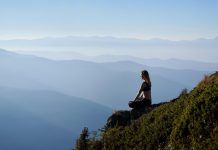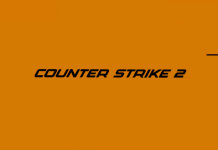Slacklining is still in its infancy, especially in India. Sean Sequeira discovers all there is to know about the ultimate sport of balance
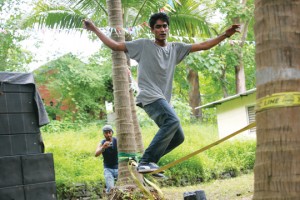 What is slacklining?
What is slacklining?
Slacklining is a sport which involves walking, jumping, balancing and performing tricks on a slackline. A slackline is a flat webbing made of nylon or polyester which can be best described as a 2-inch trampoline. Although commonly confused with tightrope walking, slacklining is entirely different since the line is not actually taut but slack with tension which allows for bouncy movement. A person who practices slacklining is called a slacker.
How did it start?
Slacklining originated when American rock climbers Adam Grosowsky and Jeff Ellington started walking on loose chains and cables between two anchor points in 1979. They later used flat webbing and started performing tricks while on the line. The sport began to grow when Scott Balcom and Chris Carpenter used nylon webbing to cross under the arches of a freeway bridge in California in 1983 at a height of 120 feet above ground thus giving rise to what is now commonly known as highlining. The most pivotal activity which brought slacklining to fame occurred on 13 July 1985 when Balcom crossed the Lost Arrow Spire highline in Yosemite National Park at a height of 2,890 feet.
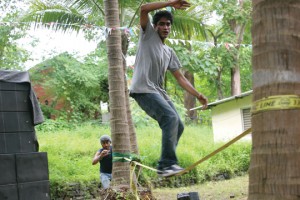 How to slackline?
How to slackline?
The best gear for a beginner is a 2-inch wide flat webbing slackline and a ratchet. The best anchor points for a slackline are trees with a minimum diameter of 12 inches and are at a distance of 15-20 feet from each other. For a beginner, it is most advisable to set up the slackline 3 feet above the ground with as much tension.
Once the slackline is set up, balancing on a single spot is the first step followed by learning to walk, walking backwards and turning on the line. Other tricks can be practised once you are more familiar. Slacklining without a safety harness is called free soloing which should be attempted only once you are well trained.
Benefits
Slacklining is known to have many benefits. Improvement of balance is the first benefit of slacklining. Many athletes use slacklining as a means to train and improve for other sports. Slacklining also improves oncentration and focus. It helps relieve stress and calm the mind. It is also an effective full body workout by building muscle and joint strength while improving posture. Slacklining is also a great leisure activity.
Styles
Slacklining can be broadly divided into:
TRICKLINING: This is the most popular form of slacklining. The slackline is usually set up 3-5 feet above the ground and is bouncy so tricks can be performed.
LONGLINING: One of the tougher styles of slacklining, longlining involves walking a slackline which is more than 30 metres in length. It requires more concentration and better quality gear.
TUNELINING: Simply put, tunelining involves playing a musical instrument while slacklining.
SLACKLINE YOGA: It combines slacklining with traditional yoga poses so as to increase the challenges and improve the experience of yoga.
WATERLINING: Any form of slackline activity conducted by setting up the slackline over water is known as waterlining.
HIGHLINING: Slacklining at a height of over 30 feet above ground is called highlining. It is one of the toughest forms of the sport as the height adds risks.
RODEO SLACKLINING: A rodeo slackline is extremely slack and has no tension. It can be setup between anchor points at 20 feet above ground but droop down to 3 feet above ground in the middle. It is extremely difficult to master.
TIMELINING: Balancing on a slackline for a certain length of time without falling or stepping off is called timelining. It requires immense concentration and endurance.
URBANLINING: Slacklining in urban areas is known as urbanlining. It can be a form of or an amalgamation of other styles of slacklining.
“My passion for doing something unique and exciting led me to learn slacklining. Not only is it a lot of fun, it can be a great workout! Balancing on a piece of webbing strengthens muscles that are hardly ever used. Slacklining serves as a wonderful form of relaxation as one must only think about balancing when you are walking on a line. You forget about the stress in your life.”
– Pooja Mehra, 37-year-old mother of two, entrepreneur
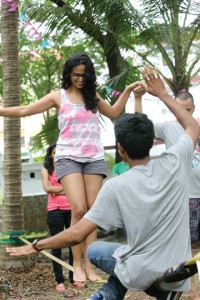 Competitions
Competitions
The World Slackline Federation (WSFed) is an officiating organisation for slacklining around the world. They are responsible for governing the quality of slacklining through requirements for teachers and world rankings of professionals. They also define scoring and refereeing criteria for competitions and uphold the quality of slacklining competitions around the world. Official slacklining competitions are ranked as:
WORLD SLACKLINE CHAMPIONSHIP
The biggest international slacklining tournament held once a year where only the top eight ranked slackers in the world are invited to compete.
NATIONAL SLACKLINE CHAMPIONSHIP
The biggest slacklining tournament to decide the best in a country for the respective year.
SLACKLINE WORLDCUP
Up to five WorldCup competitions are held in a year giving competing athletes an opportunity to gather world ranking points.
SLACKLINE OPEN
International competitions which also allot world ranking points but of lower prestige than a WorldCup. Up to 20 opens may be held in a year.
SLACKLINE JAM
Unlimited number of jams may be held in a year but they have the least amount of points allotted to competitors.
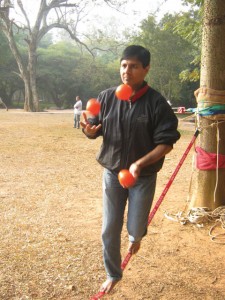 Indian community
Indian community
The slacklining community is quite small in India. A Facebook group called Slack.in is the best place to converse with fellow slackers. Founder Kunal Bedarkar says, “Slack.in was inspired by Slack.fr, the national slacklining community in France. I was hoping to bring the Indian community together to schedule activities and help each other out.”
Slacklining is mostly practiced in Hyderabad, Pune, Mumbai, Delhi and Bangalore. Cubbon Park in Bangalore is a hotspot with slacklining actitvities happening nearly everyday.
Slacklining equipment can be purchased in sporting goods store Decathlon which has over 10 outlets in India, FeetOffGround in Bangalore and Avi Industries in Mumbai. Playgroundonline.com and Playmore.in sell gear through online stores.
Tricks
Here is a list of the most popular slacklining tricks based on difficulty level
• Beginner: Walking Backwards, Turn Around, Jump Mount
• Advanced: Butt Bounce, Double Drop Knee, Front Flip Dismount, Surfing
• Expert: Back Bounce, Chest Bounce, Somersault, Cartwheel, Front Flip Landing on Line
• Extreme: Squirrel Back Flip, Butt Flip to Chest Bounce, 900 Degree Spin, Double Back Flip Dismount
Tree protection
Slackers are known to be environment-friendly. Trees are a natural anchor to set up slacklines which is why tree protection is a major concern in the slacklining community. Always use tree protection gear when setting up a slackline. This may be rudimentary like cushions and foams or professional gear from stores.
Volume 3 Issue 9

















